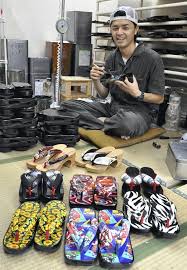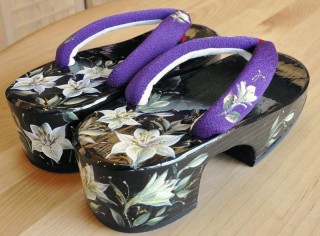Loading
Search
▼ Unique Geta Sandals: New Types of Traditional Wooden Footwear Go With Any Outfit
- Category:Shopping
HITA, Oita — Colored carp, sunflowers, zebra prints, and more. Colorful geta wooden sandals with these fancy patterns caught my eye when I visited Motono Hakimono Kogyo, a geta factory in Hita, Oita Prefecture.
“I hope people wear these fashionable geta on various occasions in their daily lives,” Masayuki Motono, the 34-year-old third-generation manager of the factory, said with a smile.
Geta, a traditional Japanese footwear, feels comfortable particularly when worn with bare feet in summer. Stylish geta can greatly add to your fashion.
Geta made at the factory are called “Hita geta” because they’re made of Hita-sugi, a local cedar. Motono said he asked local nail artists and airbrush artists to paint colorful patterns such as flowers and carp on the surfaces and heels of the geta. Some are painted in glitter and some others are rendered in great detail, including flowers with distinctive petals.
I also saw products that have thongs with the same design as the geta’s surface. Motono said the same cloth used for making the thongs is glued to the geta’s surface and covered with a special coating.
It is also possible for a customer to request geta made with cloth they provide themselves. Although they cost as much as ¥16,200 per pair, such unique products are popular among people who want original geta, Motono said.
According to an association of Hita geta manufacturers and other sources, producing the geta was encouraged by local authorities in the Edo period (1603-1867) and it became a local specialty product as a result. Cedar is a suitable material for geta because it is gentle on the feet, in addition to having a beautiful grain and being easy to work with. Although the number of geta factories peaked at about 200 after World War II, there are only 12 today.
When Motono started to help out in his family business about 10 years ago, the factory only produced plain, traditional geta. Reflecting on those days, Motono said: “As young people usually wore geta only with yukata summer kimono, they often chose cheap geta made overseas. As such cheap products are often painful to wear, I thought they ended up avoiding wearing geta.”
Motono therefore decided to make geta that people would wear even with jeans or a skirt. Hearing a female friend say she wanted geta with high heels, he worked with a woodcraft artist to make geta with nine-centimeter heels. He also asked a local airbrush artist to join his efforts.
His fresh approach gradually attracted attention and he was introduced as the “geta prince” on TV and magazines. However, Motono believes he still has much to learn from his parents about making geta.
An elegant way to wear geta, he said, is to select a pair a little smaller than the size of your feet and wear them with your heels sticking out a few centimeters.
“The Tokyo Olympics and Paralympics in four years are a good opportunity to increase the popularity of geta overseas,” Motono said. “I’d like to let people know about the advantages of geta, such as how they fit your feet better the longer you wear them.”
Geta mules
Chiezo geta mules are a popular item at Chiezo, a variety shop for kimono and traditional Japanese items in Kurume, Fukuoka Prefecture. They are original geta that have high heels just like mule sandals for women, and their thongs are made of Liberty prints or Kurume-kasuri, a splashed pattern cloth produced in Kurume and its neighborhood.
The idea was developed by Chieko Nagasue, the former owner of the shop who died three years ago. She loved kimono and hoped to create “fashionable geta that everyone feels like wearing.”
The shop’s geta are each made by hand to fit the sole. Thick thongs are used to ensure a firm fit, making them comfortable to wear for long hours and preventing or easing bunions.
“Try our geta mules. They’re good even for people who find high-heeled shoes painful,” said shop assistant Fumiko Masumoto. The mules are priced from ¥13,000 plus tax.
By Michiyo Horike / Yomiuri Shimbun Staff Writer
When Motono started to help out in his family business about 10 years ago, the factory only produced plain, traditional geta. Reflecting on those days, Motono said: “As young people usually wore geta only with yukata summer kimono, they often chose cheap geta made overseas. As such cheap products are often painful to wear, I thought they ended up avoiding wearing geta.”
Motono therefore decided to make geta that people would wear even with jeans or a skirt. Hearing a female friend say she wanted geta with high heels, he worked with a woodcraft artist to make geta with nine-centimeter heels. He also asked a local airbrush artist to join his efforts.
His fresh approach gradually attracted attention and he was introduced as the “geta prince” on TV and magazines. However, Motono believes he still has much to learn from his parents about making geta.
An elegant way to wear geta, he said, is to select a pair a little smaller than the size of your feet and wear them with your heels sticking out a few centimeters.
“The Tokyo Olympics and Paralympics in four years are a good opportunity to increase the popularity of geta overseas,” Motono said. “I’d like to let people know about the advantages of geta, such as how they fit your feet better the longer you wear them.”
Geta mules
Chiezo geta mules are a popular item at Chiezo, a variety shop for kimono and traditional Japanese items in Kurume, Fukuoka Prefecture. They are original geta that have high heels just like mule sandals for women, and their thongs are made of Liberty prints or Kurume-kasuri, a splashed pattern cloth produced in Kurume and its neighborhood.
The idea was developed by Chieko Nagasue, the former owner of the shop who died three years ago. She loved kimono and hoped to create “fashionable geta that everyone feels like wearing.”
The shop’s geta are each made by hand to fit the sole. Thick thongs are used to ensure a firm fit, making them comfortable to wear for long hours and preventing or easing bunions.
“Try our geta mules. They’re good even for people who find high-heeled shoes painful,” said shop assistant Fumiko Masumoto. The mules are priced from ¥13,000 plus tax.
By Michiyo Horike / Yomiuri Shimbun Staff Writer
- July 29, 2016
- Comment (0)
- Trackback(0)



